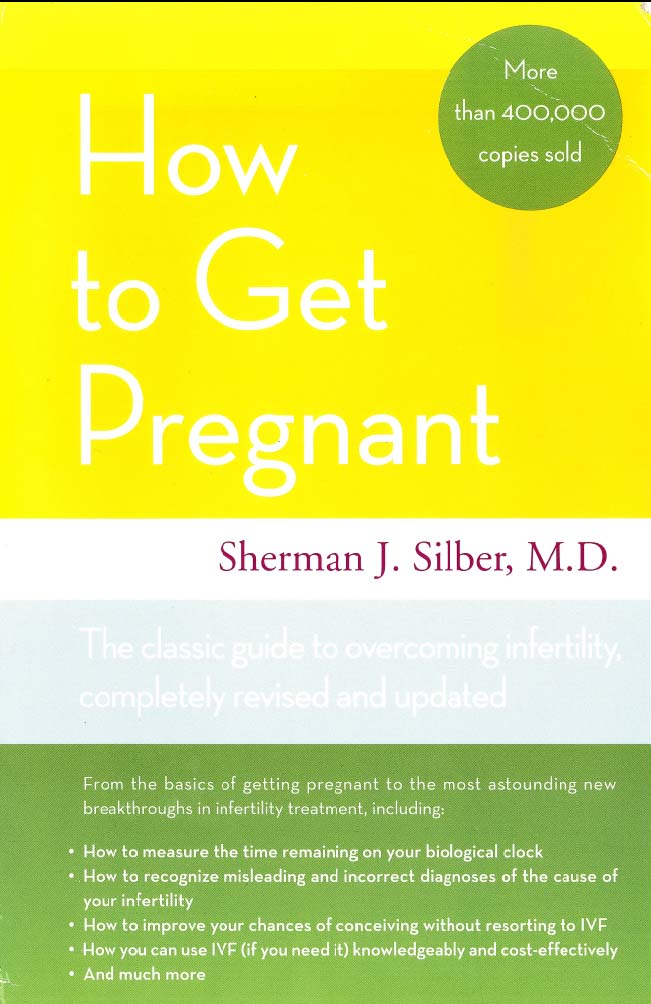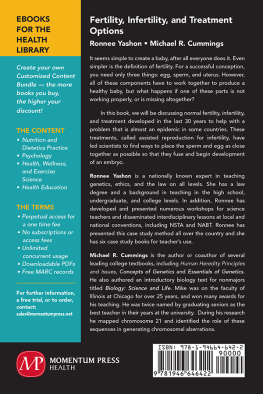Sherman J. Silber - How to Get Pregnant
Here you can read online Sherman J. Silber - How to Get Pregnant full text of the book (entire story) in english for free. Download pdf and epub, get meaning, cover and reviews about this ebook. year: 2009, publisher: Little, Brown and Company, genre: Children. Description of the work, (preface) as well as reviews are available. Best literature library LitArk.com created for fans of good reading and offers a wide selection of genres:
Romance novel
Science fiction
Adventure
Detective
Science
History
Home and family
Prose
Art
Politics
Computer
Non-fiction
Religion
Business
Children
Humor
Choose a favorite category and find really read worthwhile books. Enjoy immersion in the world of imagination, feel the emotions of the characters or learn something new for yourself, make an fascinating discovery.

- Book:How to Get Pregnant
- Author:
- Publisher:Little, Brown and Company
- Genre:
- Year:2009
- Rating:5 / 5
- Favourites:Add to favourites
- Your mark:
- 100
- 1
- 2
- 3
- 4
- 5
How to Get Pregnant: summary, description and annotation
We offer to read an annotation, description, summary or preface (depends on what the author of the book "How to Get Pregnant" wrote himself). If you haven't found the necessary information about the book — write in the comments, we will try to find it.
How to Get Pregnant — read online for free the complete book (whole text) full work
Below is the text of the book, divided by pages. System saving the place of the last page read, allows you to conveniently read the book "How to Get Pregnant" online for free, without having to search again every time where you left off. Put a bookmark, and you can go to the page where you finished reading at any time.
Font size:
Interval:
Bookmark:

Copyright 2005 by Dr. Sherman Silber
All rights reserved. Except as permitted under the U.S. Copyright Act of 1976, no part of this publication may be reproduced, distributed, or transmitted in any form or by any means, or stored in a database or retrieval system, without the prior written permission of the publisher.
Little, Brown and Company
Hachette Book Group
237 Park Avenue
New York, NY 10017
Visit our website at www.HachetteBookGroup.com
www.twitter.com/littlebrown
First eBook Edition: December 2009
The information herein is not intended to replace the services of a trained health care professional. You are advised to consult with a health care professional with regard to matters relating to your health, and in particular regarding matters that may require diagnosis or medical attention.
ISBN: 978-0-316-09330-9
To the faithful, hardworking staff at my office and at St. Lukes Hospital in St. Louis, Missouri. For three decades they have acted as tireless workers, organized scientific and medical personnel, and concerned, warm counselors to my patients. The many advances we have made would not have been possible without their exceptional dedication.
I would also like to thank basic research scientists all over the world, with whom I have worked closely, who helped to make much of this clinical progress possible. Some of those who have been especially helpful include: Dr. Frank Barnes, Dr. David Battaglia, Dr. Keith Campbell, Dr. Jacques Cohen, Dr. Jan DeVries, Dr. Paul Devroey, Dr. Robert Edwards, Dr. Kevin Eggan, Dr. Malcolm Faddy, Dr. Bart Fauser, Dr. Aono Fumihito, Dr. David Gardner, Dr. Roger Gosden, Dr. Jamie Grifo, Dr. Alan Handyside, Dr. Marc Hughes, Dr. Rob Jansen, Dr. Hubert Joris, Dr. Nori Kagawa, Dr. Osamu Kato, Dr. William Keye, Dr. Masashige Kuwayama, Dr. Jacob Levron, Dr. Willy Lissens, Dr. Jiaen Liu, Dr. Raja Mansour, Dr. Shlomo Mashiach, Dr. Colin Mathews, Dr. David Miller, Dr. Santiago Munne, Dr. Peter Nagy, Dr. David Page, Dr. Rusty Pool, Dr. Sjoerd Rep-ping, Dr. Steve Rozen, Dr. Karen Sermon, Dr. Gamal Serour, Dr. Takashi Shinohara, Dr. Roger Short, Dr. Cal Simerly, Dr. Helen Skaletsky, Dr. Andrew Speirs, Dr. Catherine Staessen, Dr. Andr Van Steirteghem, Dr. Shokichi Teramoto, Dr. Alan Trounson, Dr. Fulco Vanderveen, Dr. Yuri Verlinsky, Dr. Leandra Wilton, Dr. Robert Winston, and Dr. John Zhang.
I would also like to thank my two colleagues in St. Louis, Dr. Jorge Pineda and Dr. Michael Derosa, for their outstanding clinical attention to all our patients.
I would especially like to thank Michael Pietsch, Jack Galaska, and Susan Richman for starting me on my writing career; Bill Sarnoff, Larry Kirshbaum, and Susan Suffes for nurturing my writing over several decades; Liz Nagle for guiding me through this book; and copyeditors Shannon Langone, Peggy Freudenthal, and DeAnna Satre. Finally, I wish to thank Julie Heintzelman and Sharon Fuller for helping with the manuscript preparation, and Bill Andrea and Jen McCurdy for the illustrations.
The Infertility Epidemic
W e are in the midst of a worldwide epidemic of infertility. Ironically, even in countries with severe overpopulation, one of the most common reasons for a visit to the doctor is the inability to have children. Twenty-five percent of modern couples in their midthirties are infertile. From our teen years (when the last thing we really want is a child) to our midthirties (when we finally feel emotionally and financially secure enough to start a family), there is a twenty-five-fold decline in our ability to get pregnant. Let me explain.
Infertility is the inability to conceive despite a year or more of regular intercourse (without using birth control). The incidence of infertility in teenagers is rare. For women in their early twenties, only 1 to 2 percent are infertile. In their late twenties, 16 percent of women are infertile, and in their mid- to late thirties, 25 percent are infertile. By age forty, more than half of women are infertile, and pregnancy beyond age forty-three is very uncommon. If you are in your thirties, have been working hard to establish yourself, and are now just casually thumbing through this chapter at a local bookstore because youre thinking maybe in a few years you might like to start a family, you should realize that there is a 25 percent chance you will not be able to do so without medical intervention.
These startling figures originally came from the National Center for Health Statistics and were presented to the United States Congress through a panel assembled by the Congressional Office of Technology Assessment in 1988. I was one of five physicians on that Congressional Advisory Panel. We had witnessed an explosive increase since the 1970s in the number of couples desperately struggling to have a child, but it wasnt until these statistics were formally assembled that we were stunned to find out just how staggering the problem was. What accounts for this dramatic increase in infertility over the last forty years? The major reason for this huge increase is the womans biological clock as couples delay the age at which they try to conceive from their early twenties until their mid- to late thirties.
We could speculate about other causes: the increase in sexually transmitted diseases, environmental pollution, declining sperm count from absorption of toxic substances, and even the increased tension and anxiety of modern life. These may be modestly contributing factors, but the major reason is simply that by the time the modern couple decides to have children, usually in their thirties, the human animal is just not as fertile as it was fifteen years earlier.
I have spent some time studying aboriginal societies, most recently the Hadzi bushmen, a forty-thousand-year-old hunter-gatherer culture in a remote region of western Tanzania. These people own nothing, sleep outside without any hut or tent, and lead a tenuous existence. They marry at age thirteen or fourteen, have children, and usually die in their thirties. I asked them about infertility, and they had never heard of such a thing. Some women might stop bearing children in their mid- to late twenties, but every woman was apparently able to have children. The biology of fertility in humans has not changed in the last forty thousand years. What has changed in the last few centuries is our life span and the age at which we first try to conceive.
One of the views of the Congressional Advisory Panel (which consisted of lawyers, psychologists, sociologists, and religious leaders as well as doctors) was that society clearly benefited from people putting off childbearing until their thirties. Both men and women are now able to obtain fuller educations, develop themselves in their careers, and contribute dramatically to the intellectual and economic prosperity of the modern world. This would not occur so readily if we were saddled with children as teenagers or in our early twenties. So if society is collectively making a decision to delay childbearing, it should be no ones position to advise couples patronizingly just to hurry up and have children when theyre young.
With dramatic new technology, virtually any couple (with a few exceptions) can have a child. But you must understand the myriad complexities of your reproductive system in order to get the right help instead of the wrong help, and to deal with the emotional and financial costs the process might cause if you are not savvy. Most important, you need to understand your biological clock and how to manage it. My intention in this book is (1) to teach you how to manage your biological clock so that you wont need technology to get pregnant, and (2) to explain how you can use technology safely to get pregnant if that is currently your only option.
Font size:
Interval:
Bookmark:
Similar books «How to Get Pregnant»
Look at similar books to How to Get Pregnant. We have selected literature similar in name and meaning in the hope of providing readers with more options to find new, interesting, not yet read works.
Discussion, reviews of the book How to Get Pregnant and just readers' own opinions. Leave your comments, write what you think about the work, its meaning or the main characters. Specify what exactly you liked and what you didn't like, and why you think so.





